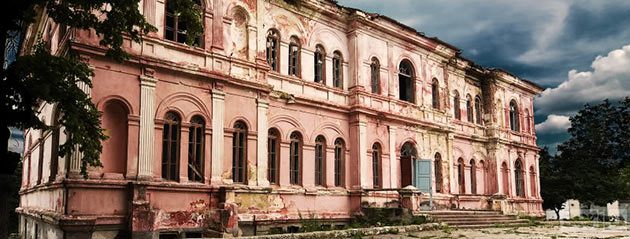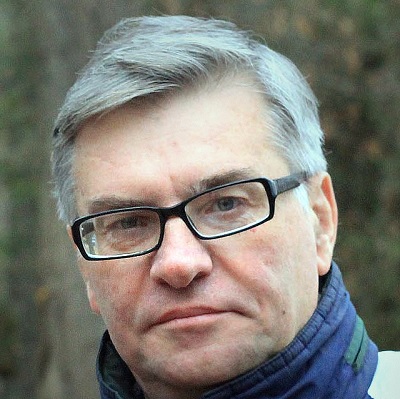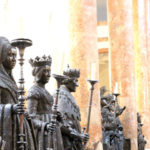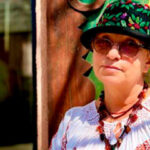Этот дворец теперь – самый известный в Молдове. Речь идет об усадьбе Манукбея в городе Хынчешть.
Его история начинается в 1813 году, когда заведующий финансами Османской империи Эммануэль (Манук) Мирзоян бежал в Бессарабию.
 Родившийся в Болгарии в 1770 году, армянин Манукбей Мирзоян в Османской империи дослужился до должности драгомана – что-то вроде современного министра иностранных дел, где он получил к своему имени приставку «бей», а позже стал заведовать финансами империи. У турок, и не без основания, возникли подозрения насчет честности христианского хранителя казны – слишком богатую он вел жизнь.
Родившийся в Болгарии в 1770 году, армянин Манукбей Мирзоян в Османской империи дослужился до должности драгомана – что-то вроде современного министра иностранных дел, где он получил к своему имени приставку «бей», а позже стал заведовать финансами империи. У турок, и не без основания, возникли подозрения насчет честности христианского хранителя казны – слишком богатую он вел жизнь.
Манукбей Мирзоян не стал дожидаться, когда его посадят на кол. Собрав родственников, все свои богатства, он перемахнул через Прут и оказался в Бессарабии. Она ему понравилась. Турок здесь, в 1813 году, уже не было. Драгоман решает осесть в Бессарабии. Местный помещик, прельщенный высокой ценой, продает Манукбею под Хынчешами свою вотчину, в которую входило около 40 сел. Среди покупок – небольшой помещичий дом в лесу под Хынчештами, теперь известный как дом графини Долгорукой. Мирзоян оказывается деятельным хозяином: закладывает в Хынчештах винокуренный завод и привозит из Турции 100 армянских семей. Их потомки живут в Хынчештах до сих пор.
Но это еще не все. Мирзоян решает построить дворец, именно дворец – три или четыре этажа, фонтаны, парк, отдельная кухня, соединенная с дворцом стеклянной галереей.
Но Мирзоян так и не построил свой дворец. Он погибает 20 июня 1817 года. Точно неизвестно, как он погиб — то ли упал с лошади, то ли отравился неизвестным ядом. Историки видят в этом руку Турецкой Порты. Уж очень хотелось туркам расквитаться с беглым драгоманом.
Его могила сохранилась до сих пор – белая мраморная плита под пристроенным сводом у армянской церкви Св. Богородицы – одного из старейших зданий Кишинева. Рядом с ним, под такими же мраморными плитами, лежат две дочери.
Тот дворцовый комплекс, реставрация которого завершается в Хынчештах, строил сын Манукбея — Иван. Имя архитектора неизвестно, но в процессе предреставрационного обмера здания архитекторы, по косвенным деталям и элементам стиля, предположили, что автор проекта – знаменитый архитектор Александр Бернардацци.
Была во дворце и замечательная роспись потолков, и делал ее никто иной, как Иван Айвазовский – знаменитый художник-маринист, сам из рода османских армян Айвазянов. Он приезжал гостить во дворец Мирзоянов, и заодно расписал потолки дворца. Росписи не сохранились, зато уцелел замечательный охотничий домик из ярко-красного кирпича, удивительно похожий на миниатюрный замок, а также руины смотровой башенки, тоже кораллово-кирпичной.
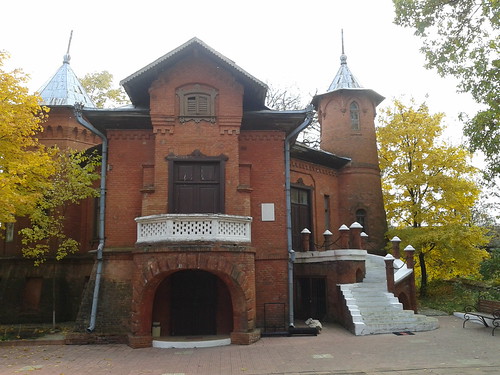
Вот замок действительно спроектировал Александр Бернардацци, выполняя в 1881 году заказ уже внука Манукбея – Георгия. Со смотровой башенки открывался замечательный вид на окрестности, особенно на северную цепь холмов, за Хынчештами, в любое время года затянутых легкой беловатой дымкой.
К тому времени, когда хозяином стал Григорий Манукбей (Мирзоян), это уже была полноценная помещичья усадьба в красивой холмистой местности, оделенная от Хынчешть невысокой грядой холмов. Усадьбу окружал густой лес. Каменная лестница спускалась к одному из двух усадебных озер. А второе озеро – большой пруд – окружал густой парк, выше которого находилось небольшое армянское кладбище. Рядом с кладбищем Мирзояны выстроили каменную церковь в армянском стиле.
Неизвестно происхождение подземных ходов. Строил ли их Манукбей Мирзоян – у него был повод опасаться мести турок, и подземные ходы пришлись бы кстати, или их строил кто-то другой, до или после него?… Один из подземных ходов тянется через все Хынчешты, с юга на север. А другой заканчивается у сохранившегося озера бывшей усадьбы. Качественно построенные подземные ходы оказались очень кстати для многих жителей Хынчешь – они с удовольствием устраивают в них погреба и подвалы.
Потомки Манукбея владели усадьбой до 1905 года. А потом она пошла по рукам, пока, после войны, в бывшем дворце не открыли строительный техникум. А в замечательном охотничьем замке устроили леспромхоз. Начиная с 50-х годов, возле здания техникума – бывшего дворца, строили безликие корпуса общежитий. Церковь не вписывалась в новую идеологию, и в 1947 году ее снесли. Перепахали и бывшее армянское кладбище – до сих пор здесь поле. Постепенно город надвинулся на бывшую усадьбу Манукбея, частные дома окружили усадьбу, проникли на ее территорию и пошли дальше, на юг.
Да и само здание дворца, став техникумом, опростилось –красную черепичную крышу сменил скучный серый шифер; исчезли с крыши и орнаментальные украшения. После землетрясения 31 августа 1986 года здание бывшего дворца признали аварийным. Для техникума на месте снесенной усадебной церкви в 1991 году построили новое здание. В 1993 году бывший дворец признали памятником архитектуры и… благополучно забросили. Он стоял, никому не нужный, постепенно разрушаясь.
А в начале 2000 годов вдруг спохватились – все-таки, памятник, да еще построенный знаменитым архитектором. Пошли толки, кому должно принадлежать здание, и кто возьмется его реставрировать. Приезжал из Румынии миллионер Гюльбекян – нефтяной магнат армянского происхождения, интересовался дворцом. Но здание осталось государственной собственностью. В 2006 всерьез заговорили о его реставрации, а приступили к ней только в конце прошлого года. Пока занялись дворцом – его восстановят и придадут ему первоначальный вид. Не будет лишь потолочных росписей Айвазовского. Они полностью уничтожены, и как они выглядели, неизвестно. Уже отреставрирован дом графини Долгорукой, тот самый, который 200 лет назад приобрел опальный драгоман Манукбей. Восстановят и смотровую башенку из красного кирпича, с верхней террасы которой гости и хозяева любовались окрестностями.
Шли разговоры о восстановлении армянской церкви, но пока дальше разговоров не пошло. Слишком дорого, да и много ли армян в Хынчешть? Более реальны планы открыть при музейном комплексе ресторан армянской кухни, но это план на перспективу – когда возрожденный дворец действительно привлечет большое количество туристов.
Олег ТАЦЕНКО
Статья была любезно предоставлена журналом Altitude — Air Moldova
English version: Manuc Bei’s Homestead
This palace is arguably the most famous in Moldova – we are talking about the country estate of Manuc Bei in Hincesti.
Its history begins in 1813, when the Chief of finance of Ottoman Empire Emanuel (Manuc) Mirzoyan ran fled to Bessarabia.
 Born in Bulgaria in 1770 to Armenian parents, Manuc Bei Mirzoyan worked his way up to “dragoman” in Ottoman Empire – something of a minister of foreign affairs, thus gaining “bei” prefix to his name, and later went to become one to manage the finances of the Empire. At some point, Turks became suspicious about honesty of a Christian treasurer – too wealthy and posh was his way of living.
Born in Bulgaria in 1770 to Armenian parents, Manuc Bei Mirzoyan worked his way up to “dragoman” in Ottoman Empire – something of a minister of foreign affairs, thus gaining “bei” prefix to his name, and later went to become one to manage the finances of the Empire. At some point, Turks became suspicious about honesty of a Christian treasurer – too wealthy and posh was his way of living.
Manuc Bei Mirzoyan decided not to wait for his justified impalement – having gathered his relatives and riches, he crossed river Prut and found himself in Bessarabia. He liked the place; there were no more Turks here in 1813. Dragoman decided to settle down – local landlord, seeing big profits, sells to Manuc Bei his patrimony under Hincesti, consisting of around 40 villages. Among his new acquisitions there was a small manor house in the woods near Hincesti, now known as house of countess Dolgorukaya. Mirzoyan turns out to be an effective proprietor: he builds a distilling factory in Hincesti and brings from Turkey approximately 100 Armenian families. Their descendants live in Hincesti to this day.
However, there is more. Mirzoyan decides to build a palace, literally – three or four floors high with fountains, a park, and a separate kitchen, connected to the palace with a glass passage.
Marzayan, unfortunately, never finished this project – he tragically died on June 20th in 1817. The cause of his death was not documented – it is marked as an “accident,” and can mean anything from falling of a horse to being poisoned. Some historians see in this the long hand of Ottoman Porte – it might as well be that Turks really wanted to punish the runaway dragoman.
His grave is kept until nowadays in the place where his was buried – white plate of marble under an attached arch at the Armenian Church of Holy Mother of God, one of the oldest buildings in Chisinau. With dragoman, under the similar marble plates, lie two daughters of Manuc Bei Mirzoyan.
The palace mentioned above – restoration of which is currently coming to an end in Hincesti – was built by his son, Ivan. Architect’s name is unknown, but in the process of pre-restoration measurements, looking at certain details and elements of style the architects had assumed that the head of the project might have been a well-known architect, Alexander Bernardazzi.
At some point, the palace had beautiful painted ceilings – made by none other than Ivan Aivazovsky, one of the greatest marine artists in history, himself also from the family of Ottoman Armenians, Aivazian. He visited the Mirzoyans’ palace and, on the side, painted the ceilings. These paintings were not saved, unlike a remarkable hunting lodge of red brick looking like a miniature castle, as well as the ruins of a small watchtower.

This small castle was indeed a project of Alexander Bernardazzi, who in 1881 was working on an order from Manuc Bei’s grandson, Georgy. This watchtower had a wonderful view on the surroundings – especially the north chain of hills behind Hincesti, all year long covered by a subtle white haze.
When Gregory Manuc Bei (Mirzoyan) became the owner of the place, it was already an actual manor in a beautiful hilly area, separated from Hincesti by another low ridge. It was surrounded by a dense forest, a stone stairway connected it to one of the two manor lakes, while the second lake – more like a big pond – was in the middle of a park, above which a small Armenian cemetery was located. Next to the cemetery, Mirzoyans have founded an Armenian style stone church.
The origins of the underground passages are unknown. Who built them – Manuc Bei himself in fear of retribution from the Turks, thinking that these will come in handy when the need arrives, or someone else, before or after him?… One of these passages runs through the whole city of Hincesti, from South to North. Another ends at the remaining lake of the former manor. Well-made passages are a good thing for many inhabitants of Hincesti – they make great cellars and basements.
Manuc Bei’s descendants owned the manor until 1905 – after that it was “passed around,” until after the war the manor was turned into a Civil Engineering school, while the beautiful lodge-castle became a timber industry building. Starting from the 50-s, featureless campus buildings began springing up around the former palace; the church did not fit into the new ideology and was demolished. Armenian cemetery was turned into a growing field, which is still there. Over time, the city slowly took over the former Manuc Bei’s manor; private houses surrounded it, entered its territory and moved on, to the South.
Furthermore, the palace itself, after being turned into a college, became more plain – red tile roof was switched for boring gray slate and the roof decorations went with the tile. After an earthquake on August 31, 1986, the building was declared to be in an emergency state. For the college, instead of the demolished church, a new building was made in 1991. In 1993 the former palace was declared an architectural monument… and successfully abandoned. There it stood, unwanted, slowly deteriorating.
Only in the beginning of 2000 it was suddenly remembered of – the palace is, actually, a monument; built by a famous architect, too. Discussions began about who should it belong to and who will take on to restore it. Gyulibekian, an oil magnate with Armenian origins – came from Romania displaying interest in the palace. However, the building remained the property of the state. Year 2006 marked the beginning of serious discussions regarding it restoration – unfortunately, it actually began only at the end of the last year. Restoration is now mainly focused on the palace itself – it will be renewed and brought to its former appearance. The only thing missing will be the ceiling paintings by Aivazovsky – they were completely ruined and it is unknown what they looked like before this happened. The restoration of the house of countess Dolgorukaya is now finished – that same building, which 200 years ago was bought by the disgraced dragoman Manuc Bei. It is also planned to restore the watchtower of red brick, from the upper terrace of which the hosts and their guests could admire the surroundings.
There were talks about restoring the Armenian Church, but it did not go past the talks yet. It is too expensive, and it does not seem there are many Armenians in Hincesti. It is much more realistic to open a restaurant serving Armenian cuisine next to the museum complex, but even now it is just a distant possibility – when the revived palace actually begins attracting a big amount of tourists.
Oleg TATSENKO
Altitude — Air Moldova

